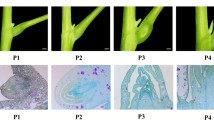Abstract
Genetic, physiological, and morphological studies of dwarf mutants of Arabidopsis thaliana (L.) Heynh. from the collection of the Department of Genetics and Breeding, Moscow State University, showed that the NA and LE genes are involved in regulating elongation of internode cells and sensitivity to various hormones. The na mutation suppressed stem growth only in the presence of the active LE gene. The absence of the LE activity (in the lele homozygote) restored stem growth of the na mutant to the level characteristic of thele-2 mutant, and a decrease inLE activity (in LE/le heterozygote) almost completely suppressed the na phenotype. Phenotypic analysis of homozygous double mutants and heterozygotes obtained by crossing the na and le-2 mutants showed that the recessive le-2 allele has an epistatic effect on the semidominant na allele and that the genes possibly control consecutive steps of one biochemical pathway or one morphogenetic process. A hypothetical scheme was proposed for the interaction of the NA and LE gene products.
Similar content being viewed by others
REFERENCES
Reid, J.B. and Howell, S.H., Hormone Mutants and Plant Development, Plant Hormones Physiology, Biochemistry and Molecular Biology, Davies, P.J., Ed., Kluwer Academic, 1995, pp.448–485.
Clouse, S.D. and Sasse, J.M., Brassinosteroids: Essential Regulators of Plant Growth and Development, Annu.Rev. Physiol. Plant Mol. Biol., 1998, vol.49, pp. 427–451.
Tian, Q. and Reed, J.W., Control of Auxin-Regulated Root Development by the Arabidopsis thaliana SHY2/IAA3 Gene, Development (Cambridge, UK), 1999, vol. 126, pp. 711–721.
Dubois, F., Bui Dang Ha, D., Sangwan, R.S., and Durand, J., The Petunia tra1 Gene Controls Cell Elongation and Plant Development, and Mediates Responses to Cytokinins, Plant J., 1996, vol. 10, no.1, pp.47–59.
Ezhova, T.A., Ondar, U.N., Soldatova, O.P., and Mamanova, L.B., Genetic and Physiological Analysis of Dwarf Mutants of Arabidopsis thaliana (L.) Heynh., Ontogenez (Moscow), 1997, vol. 28, no. 5, pp.344–351.
Ezhova, T.A., Soldatova, O.P., and Sklyarova, O.A., The NANA Gene Regulates Division and Elongation of StemCells in Arabidopsis thaliana (L.) Heynh., Genetika (Moscow), 2002, vol. 38, no. 1, pp. 63–71.
Choe, S., Dilkes, B.P., and Gregory, B.D., The Arabidopsisdwarf1 Mutant Is Defective in the Conversion of 24-Methylenecholesterol to Campesterol in Brassinosteroid Biosynthesis, Plant Physiol., 1999, vol. 119, no. 3,pp. 897–907.
Yanushkevich, S.I., Ispol'zovanie arabidopsisa v prakticheskikhzanyatiyakh po obshchei genetike (The Use of Arabidopsis in a Laboratory Course of General Genetics), Moscow: Mosk. Gos. Univ., 1985.
Murashige, T. and Skoog, F., A Revised Medium for the Plant Growth and Bioassays with Tobacco Tissue Culture,Physiol. Plant., 1962, vol. 15, pp. 473–497.
Kvitko, K.V., An Aseptic Arabidopsis thaliana Culture and the Prospects of Its Use in Botanic Studies, Vestn.Len. Univ., Ser. Biol., 1960, vol. 15, no. 3, pp. 47–56.
Li, J., Nagpal, P., Vitart, V., et al., A Role for Brassinosteroidsin Light-Dependent Development of Arabidopsis,Science, 1996, vol. 272, pp. 398–401.
Ezhova, T.A., Soldatova, O.P., Ondar, U.N., et al., Nor-flurazone-Tolerant Dwarf Mutants of Arabidopsis as Models to Study the Resistance to Oxidative Stress, Fiziol. Rast. (Moscow), 1997, vol.44, no. 5, pp. 665–670.
Ephritikhine, G., Fellner, M., Vannini, C., et al., The sax1 Dwarf Mutant of Arabidopsis thaliana ShowsAltered Sensitivity of Growth Responses to Abscisic Acid, Auxin, Gibberellin and Ethylene and Is Partially Rescued by Exogenous Brassinosteroid, Plant J., 1999,vol. 18, no. 3, pp.303–313.
Ephritikhine, G., Pagant, S., Fujioka, S., et al.,The sax1 Mutation Defines a New Locus Involved in the BrassinosteroidBiosynthesis Pathway in Arabidopsis thaliana, Plant J., 1999, vol. 18, no. 3, pp. 315–321.
Lu, C. and Fedoroff, N., A Mutation in the Arabidopsis HYL1 Gene Encoding a dsRNA-Binding Protein AffectsResponses to Abscisic Acid, Auxin and Cytokinin, Plant Cell, 2000, vol. 12, pp.2351–2366.
Author information
Authors and Affiliations
Rights and permissions
About this article
Cite this article
Lebedeva, O.V., Sklyarova, O.A. & Ezhova, T.A. The Roles of the NANA and LEPIDA Genes in Regulating the Stem Growth in Arabidopsis thaliana . Russian Journal of Genetics 40, 764–771 (2004). https://doi.org/10.1023/B:RUGE.0000036526.13587.a6
Issue Date:
DOI: https://doi.org/10.1023/B:RUGE.0000036526.13587.a6




